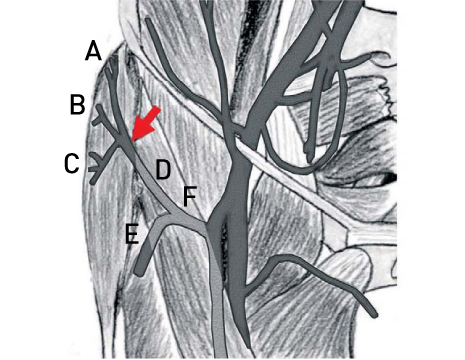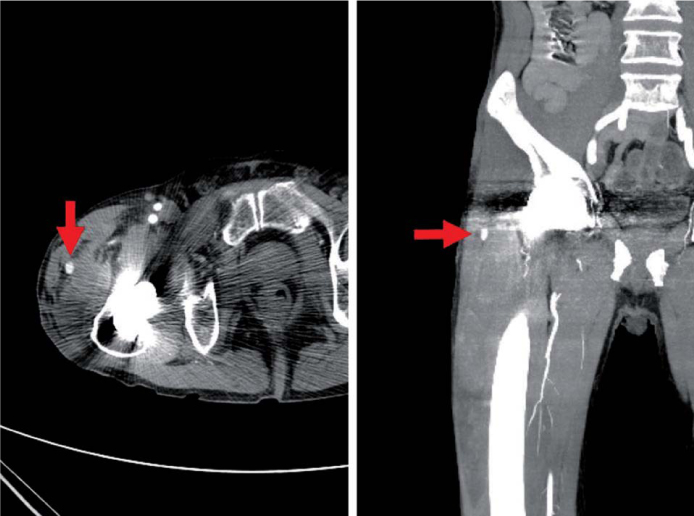Hip Pelvis.
2013 Dec;25(4):297-300. 10.5371/hp.2013.25.4.297.
A Vessel Injury by Trocar of Closed Suction Drainage after Hip Hemiarthroplasty: A Case Report
- Affiliations
-
- 1Department of Orthopaedic Surgery, Dong-Eui Medical Center, Busan, Korea. wonro@hanmail.net
- KMID: 1808139
- DOI: http://doi.org/10.5371/hp.2013.25.4.297
Abstract
- Vascular complication of hip arthroplasty is relatively rare, and usually involves iatrogenic injury or thrombus formation of main vessels. No case of vascular injury associated with closed suction drainage has been reported. The current report describes an injury of a branch from the lateral circumflex femoral artery caused by a trocar of closed suction drainage in a 72-year-old man who had been treated with bipolar hemiarthroplasty because of a femoral neck fracture. We report on this case with a review of the literature in order to avoid similar complications.
Keyword
MeSH Terms
Figure
Reference
-
1. Callaghan JJ, Rosenberg AG, Rubash HE. The adult hip. 2nd ed. Philadelphia: Lippincott Williams & Wilkins;2007. p. 1103–1104.2. Bach CM, Steingruber IE, Ogon M, Maurer H, Nogler M, Wimmer C. Intrapelvic complications after total hip arthroplasty failure. Am J Surg. 2002; 183:75–79.
Article3. Nachbur B, Meyer RP, Verkkala K, Zürcher R. The mechanisms of severe arterial injury in surgery of the hip joint. Clin Orthop Relat Res. 1979; (141):122–133.
Article4. Holt BT, Parks NL, Engh GA, Lawrence JM. Comparison of closed-suction drainage and no drainage after primary total knee arthroplasty. Orthopedics. 1997; 20:1121–1124.
Article5. Sundaram RO, Parkinson RW. Closed suction drains do not increase the blood transfusion rates in patients undergoing total knee arthroplasty. Int Orthop. 2007; 31:613–616.
Article6. Beer KJ, Lombardi AV Jr, Mallory TH, Vaughn BK. The efficacy of suction drains after routine total joint arthroplasty. J Bone Joint Surg Am. 1991; 73:584–587.
Article7. Ovadia D, Luger E, Bickels J, Menachem A, Dekel S. Efficacy of closed wound drainage after total joint arthroplasty. A prospective randomized study. J Arthroplasty. 1997; 12:317–321.8. Valdatta L, Tuinder S, Buoro M, Thione A, Faga A, Putz R. Lateral circumflex femoral arterial system and perforators of the anterolateral thigh flap: an anatomic study. Ann Plast Surg. 2002; 49:145–150.
Article9. Xu DC, Kong JM, Zhong SZ. The ascending branch of the lateral circumflex femoral artery. A new supply for vascularized iliac transplantation. Surg Radiol Anat. 1989; 11:263–264.
Article
- Full Text Links
- Actions
-
Cited
- CITED
-
- Close
- Share
- Similar articles
-
- Dissociation Between Polyethylene and Inner Prosthetic Ball Head During Closed Reduction of a Dislocated Bipolar Hip Hemiarthroplasty: A Report of 3 Cases
- Polished Tapered Femoral Stem Displacement during the Closed Reduction of a Redislocated CementedBipolar Hemiarthroplasty of the Hip: A Case Report
- Thrombotic Occlusion of the External Iliac and Popliteal Arteries after Hip Hemiarthroplasty: A Case Report
- The Effect of Closed-Suction Drainage After Total Knee Arthroplasty
- Unipolar Versub Bipolar Hip Hemiarthroplasty for Fractures of Femoral Neck in the Dlderly





